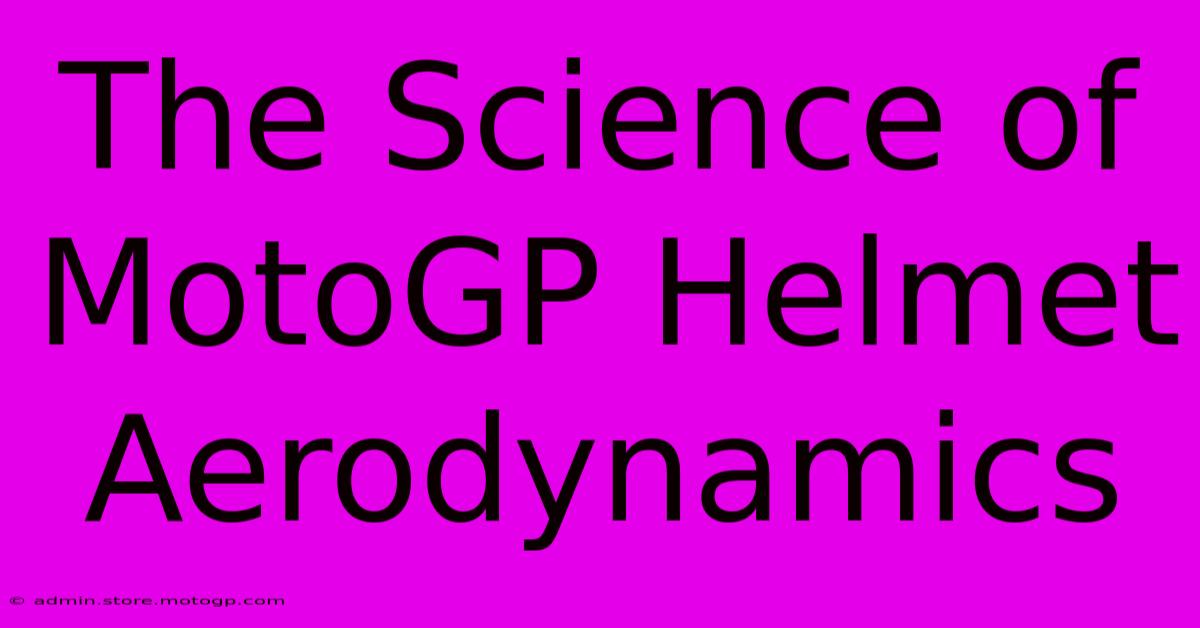The Science Of MotoGP Helmet Aerodynamics

Table of Contents
The Science of MotoGP Helmet Aerodynamics: A Deep Dive
MotoGP racing is a relentless pursuit of speed and efficiency. Every detail, from the bike's chassis to the rider's gear, is meticulously engineered for optimal performance. One often-overlooked but critically important aspect is the rider's helmet. Far from just a protective shell, modern MotoGP helmets are sophisticated pieces of aerodynamic engineering, impacting rider performance and safety in significant ways. This article explores the fascinating science behind these high-tech head protectors.
The Aerodynamic Challenges Faced by MotoGP Riders
MotoGP riders experience extreme aerodynamic forces at speeds exceeding 200 mph (320 km/h). These forces are not only directed at the motorcycle but also directly impact the rider, particularly the head and helmet. These challenges include:
- High-Speed Airflow: The sheer speed of the bike generates significant drag and turbulent airflow around the rider's head, potentially causing instability and hindering performance.
- Buffeting: Turbulence from the bike and other elements on the track creates buffeting effects, leading to discomfort, fatigue, and reduced concentration for the rider.
- Neck Strain: The aerodynamic forces exerted on the helmet can create significant neck strain, particularly during high-speed cornering and braking.
Minimizing Drag and Maximizing Stability
Helmet design plays a crucial role in mitigating these aerodynamic challenges. Manufacturers employ sophisticated Computational Fluid Dynamics (CFD) simulations and wind tunnel testing to optimize helmet shape and features. Key design elements include:
- Streamlined Shape: The helmet's overall shape is meticulously designed to minimize drag and promote smooth airflow. This often involves a smoothly curved profile with minimal sharp edges or protrusions.
- Air Vents and Extractors: Strategically placed vents channel air over and around the helmet, reducing pressure build-up and minimizing buffeting. Extractors at the rear help to manage airflow separation, reducing drag and improving stability.
- Spoiler and Winglet Integration: Some high-end helmets incorporate small spoilers or winglets, similar to those found on race cars. These elements are carefully designed to manage airflow and generate downforce, keeping the helmet stable at high speeds.
The Materials and Construction of MotoGP Helmets
The materials used in constructing a MotoGP helmet are as crucial as the aerodynamic design. These helmets must offer exceptional protection against high-impact forces while remaining lightweight and aerodynamically efficient.
- Carbon Fiber Composites: Lightweight yet incredibly strong, carbon fiber is the material of choice for most MotoGP helmets. Its high strength-to-weight ratio allows for optimal aerodynamic performance without compromising safety.
- Advanced Polymers: Other high-performance polymers may be incorporated to enhance specific properties, such as impact resistance or flexibility.
- Inner Liner Design: The inner liner plays a crucial role in managing impact energy and providing comfort for the rider. Advanced materials and padding are used to optimize both safety and fit.
The Role of Wind Tunnel Testing and CFD Simulation
Wind tunnel testing and CFD (Computational Fluid Dynamics) simulations are essential to the development process of MotoGP helmets. These tools allow engineers to visualize airflow patterns around the helmet, identify areas of high pressure and turbulence, and fine-tune the design to optimize aerodynamic performance and minimize drag.
Wind Tunnel Testing: This involves placing a prototype helmet in a wind tunnel and measuring the forces exerted on it at various speeds and angles. This provides critical data that informs the design process.
CFD Simulation: CFD software allows engineers to create a virtual model of the helmet and simulate airflow around it. This is a cost-effective way to test numerous design iterations before moving to physical prototypes.
The Future of MotoGP Helmet Aerodynamics
The pursuit of aerodynamic perfection in MotoGP is ongoing. As speeds continue to increase, so too does the demand for even more sophisticated helmet designs. Future advancements may include:
- Adaptive Aerodynamics: Helmets with adjustable components that can alter their aerodynamic properties based on speed and track conditions.
- Advanced Materials: The development of new lightweight and high-strength materials will allow for even more refined designs.
- Integrated Sensors: Integration of sensors to monitor helmet performance and rider biometrics could provide valuable data for further refinement.
The science behind MotoGP helmet aerodynamics is a testament to the constant innovation and pursuit of performance within the sport. Every detail, from the helmet's shape to the materials used, contributes to the rider's safety, comfort, and ultimately, their competitive edge. This is a field where cutting-edge technology and meticulous engineering combine to create headgear that's more than just a protective shell; it's a crucial component of a winning strategy.

Thank you for visiting our website wich cover about The Science Of MotoGP Helmet Aerodynamics. We hope the information provided has been useful to you. Feel free to contact us if you have any questions or need further assistance. See you next time and dont miss to bookmark.
Featured Posts
-
The Psychology Of The F1 Starting Grid Pressure And Performance
Feb 19, 2025
-
Austin Gp Concert Get Your Groove On
Feb 19, 2025
-
Moto Gp Points What Every Fan Should Know
Feb 19, 2025
-
F1 Fans Prepare For Tomorrows Electrifying Starting Grid
Feb 19, 2025
-
Motorbike Racing A World Of Possibilities
Feb 19, 2025
